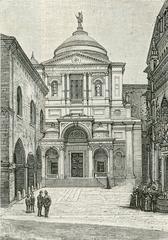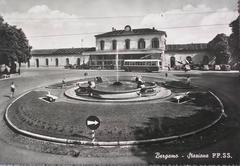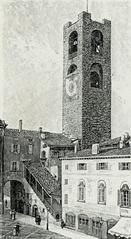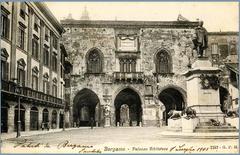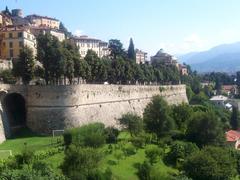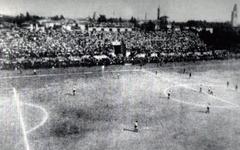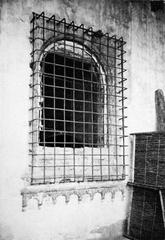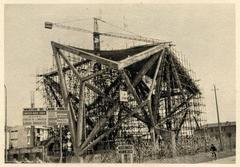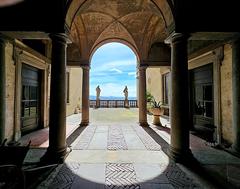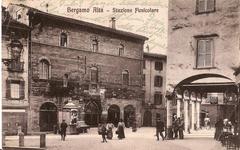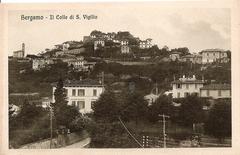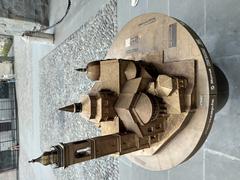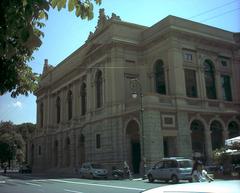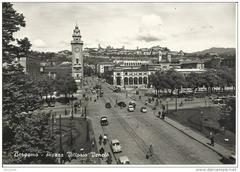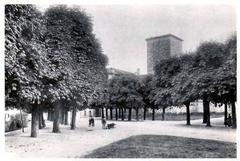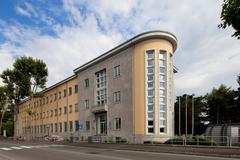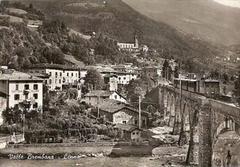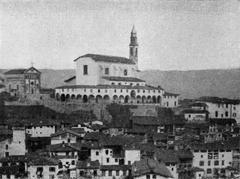
Lodi–Treviglio–Bergamo Tramway: Visiting Hours, Tickets, and Travel Guide
Date: 04/07/2025
Introduction
The Lodi–Treviglio–Bergamo Tramway stands as a fascinating testament to Northern Italy’s industrial and social evolution. Established in the late 19th century, this steam-powered tramway bridged the agricultural and industrial hubs of Lodi, Treviglio, and Bergamo, stretching over 45 kilometers across Lombardy. It not only facilitated economic growth and urban expansion but also fostered cultural integration and regional identity. Although the original tramway ceased operations in the 20th century, its legacy endures through repurposed routes, modern tram networks, and active heritage preservation. This guide offers a comprehensive overview of the tramway’s history, practical visitor information, modern successors, and travel tips, ensuring an enriching experience for all travelers (fr.wikiital.com, urbanrail.net, Visit Bergamo, Visit Lodi, Bergamo Tourism Office, TEB Official Website).
Table of Contents
- Historic Overview and Early Development
- Technical Features and Route
- Management, Operations, and Impact
- Decline, Legacy, and Modern Revival
- Heritage Visits: Hours, Tickets, and Tips
- Route and Key Stops
- Modern Successor: T1 Tramway
- Landmarks and Attractions
- Visitor FAQ
- Socio-Economic Role and Community
- Regional Transport and Sustainable Futures
- Summary and Visiting Tips
- References and Further Reading
Historic Overview and Early Development
The Lodi–Treviglio–Bergamo Tramway was conceived in the 1870s, amid burgeoning industrialization in Lombardy. Initiated by Ferdinando Pistorius and a group of financiers, the project aimed to connect Lodi, Treviglio, and Bergamo with an efficient steam tramway. The concession process began in June 1879 and quickly gained approval from Bergamo, Milan, and Cremona provincial authorities. Construction proceeded rapidly, with the Treviglio–Bergamo section opening in August 1880 and the extension to Lodi completed by June 1881 (fr.wikiital.com).
The tramway immediately became a vital corridor, linking rural towns to urban economies and establishing a foundation for subsequent urban growth and social integration.
Technical Features and Route
The tramway was a single-track, standard-gauge (1,445 mm) line spanning 45.6 km, with the majority of its length situated in Bergamo province. The route paralleled provincial roads—Bergamina and Treviglio–Bergamo—using both dedicated and shared alignments. In urban settings, raised curbs separated tram lines from regular road traffic, reflecting contemporary safety practices.
Steam locomotives, initially adapted for road use, pulled up to four (sometimes six) carriages, serving both passengers and freight. The tramway connected with other regional lines, enhancing interurban mobility and commerce.
Management, Operations, and Impact
In 1883, the concession was transferred to the Società Anonima Tramvie Interprovinciali Milano-Bergamo-Cremona (later Tramvie Interprovinciali Padane - TIP). The company divided passenger services into two main segments: Bergamo–Treviglio and Treviglio–Lodi, running several daily trains. The Bergamo terminus, strategically positioned between the Valle Brembana and Valle Seriana railways, enabled seamless transfers and integrated the city’s growing electric tram network.
The tramway’s presence was transformative—connecting rural communities to urban life, stimulating local economies, and inspiring the creation of Bergamo’s extensive urban tram system.
Decline, Legacy, and Modern Revival
By the early 20th century, the advent of automobiles, improved roads, and flexible bus systems led to the tramway’s gradual decline. Sections were phased out in the 1920s, with full closure by the mid-20th century. Despite its disappearance, the tramway’s legacy shaped regional transport planning and urban development for decades.
Today, its spirit is revived in the T1 light-rail line (opened in 2009), which follows historic corridors and employs state-of-the-art technology. The upcoming T2 line to Villa d’Almè will further expand sustainable public transport in Bergamo (urbanrail.net, urban-transport-magazine.com, railwaypro.com).
Heritage Visits: Hours, Tickets, and Tips
Visiting Hours and Tours
While the original tramway is no longer operational, its heritage is celebrated through historical sites, museums, and repurposed trackbeds. Most outdoor sites and paths are accessible year-round. Museums—such as the Bergamo Transport Museum—are typically open Tuesday to Sunday, 9:00 AM to 6:00 PM. Guided tours are available seasonally; check local tourism websites for current schedules (Visit Bergamo, Visit Lodi).
Tickets and Access
No ticket is required to walk or cycle along the old route or visit most outdoor sites. Museum entry is affordable, often with discounts for students and seniors. For the modern T1 and T2 lines, tickets can be purchased at stations, kiosks, or via mobile apps (ATB Bergamo).
Accessibility
Modern tram lines and most museums are fully accessible, with step-free entry, tactile maps, and audio-visual aids. Some historic paths may have uneven surfaces, so check with individual venues for accessibility details.
Travel Tips
- Wear comfortable footwear for walking or cycling heritage paths.
- Use integrated ticketing for seamless travel between trams, buses, and trains.
- Park-and-ride facilities are available at major stops.
- Cycling is encouraged with bike-sharing and path connections.
Route and Key Stops
Lodi
A historic city on the Adda River, Lodi’s Porta Milano (Due Porte) tram station featured a unique multi-level design and served as a central hub for several lines.
Sant’Angelo Lodigiano
Known for its medieval castle and markets, the tram stop here enabled both local commerce and social interaction.
Melegnano
Home to the largest tram station in Lombardy, with four tracks, a freight yard, and passenger amenities. Some original buildings are still present.
Salerano sul Lambro (“La Stasiuneta”)
The former station is now a trattoria, showcasing adaptive reuse. Historically, it was a key midpoint with facilities for passengers and early telegraph connections.
Treviglio
Critical interchange for connections to the mainline railway and branching toward Bergamo.
Bergamo
The northern terminus, distinguished by its dual city structure—Lower City and the UNESCO-listed Upper City—now served by the modern T1 tramway.
Modern Successor: T1 Tramway
The T1 line, operated by TEB, revitalizes the tramway tradition with a 12.5 km route from Bergamo to Albino. Serving over 220,000 residents, it connects key towns and offers frequent, accessible service. The T2 line, opening in 2026, will further extend the network (TEB Official Website).
Key T1 Stops:
- Bergamo Martinella (park-and-ride, bus links)
- Torre Boldone (cycle and pedestrian access)
- Ranica, Alzano Lombardo, Nembro, Pradalunga, Albino (northern terminus with extensive facilities)
Landmarks and Attractions
- Giardini del Passeggio, Lodi: Historic iron bridge site, now a scenic garden.
- Piazza Garibaldi, Melegnano: Former tram hub and community center.
- Città Alta, Bergamo: Medieval upper city accessible by funicular, renowned for its views and heritage (Rough Guides).
While tracing tramway heritage, visitors can explore Renaissance piazzas in Lodi, vibrant markets in Treviglio, and Bergamo’s cultural landmarks.
Visitor FAQ
Q: Are original tramway vehicles on display?
A: Some museums preserve artifacts and photographs, though original vehicles are rarely found.
Q: Can I walk or cycle the old tram route?
A: Yes, several sections have been converted into public paths.
Q: How do I buy tickets for the modern tramway?
A: Purchase at stations, kiosks, or via mobile apps. Integrated tickets cover trams, buses, and trains.
Q: Is the tramway accessible for people with disabilities?
A: Modern lines and most museums offer full accessibility.
Q: Are guided tours available?
A: Yes, through local tourism offices and cultural associations—check ahead for schedules.
Socio-Economic Role and Community
The tramway was crucial in reducing travel times and costs, supporting local economies, and uniting rural and urban populations (Lombardi Archivi). Its legacy continues through community engagement, annual festivals, and advocacy for sustainable, integrated transport.
Regional Transport and Sustainable Futures
Debates about reviving the tramway—sometimes called the “T3”—reflect ongoing interest in sustainable alternatives to new highways. Advocates point to successful tram expansions in other European cities and emphasize benefits for the environment, economy, and regional cohesion (BergamoNews, Wikipedia). Modern public transport in Bergamo builds on this heritage, offering frequent, accessible, and sustainable travel options.
Summary and Visiting Tips
The Lodi–Treviglio–Bergamo Tramway is a living chapter of Lombardy’s industrial and cultural history. Its heritage can be explored through museums, walking and cycling paths, and integrated modern tram services. Plan your visit using official tourism resources, enjoy guided tours, and experience the unique blend of history, landscape, and innovation that defines this route.
For real-time updates, maps, and personalized itineraries, download the Audiala app and follow official tourism channels (Audiala App, Visit Bergamo, Visit Lodi).
References and Further Reading
- Exploring the Lodi–Treviglio–Bergamo Tramway: History, Visitor Information, and Bergamo’s Historic Transport Sites, 2025, Various Authors (fr.wikiital.com)
- Exploring the Lodi–Treviglio–Bergamo Tramway: History, Visitor Info, and Nearby Attractions, 2025, Various Authors (Visit Bergamo, Visit Lodi)
- Exploring the Lodi–Treviglio–Bergamo Tramway: History, Key Stops, Visitor Information, and Travel Tips, 2025, Various Authors (urbanrail.net, ATB Bergamo)
- Lodi-Treviglio-Bergamo Tramway: History, Revival, and Future of Sustainable Transport in Bergamo, 2025, Various Authors (BergamoNews, Wikipedia)





